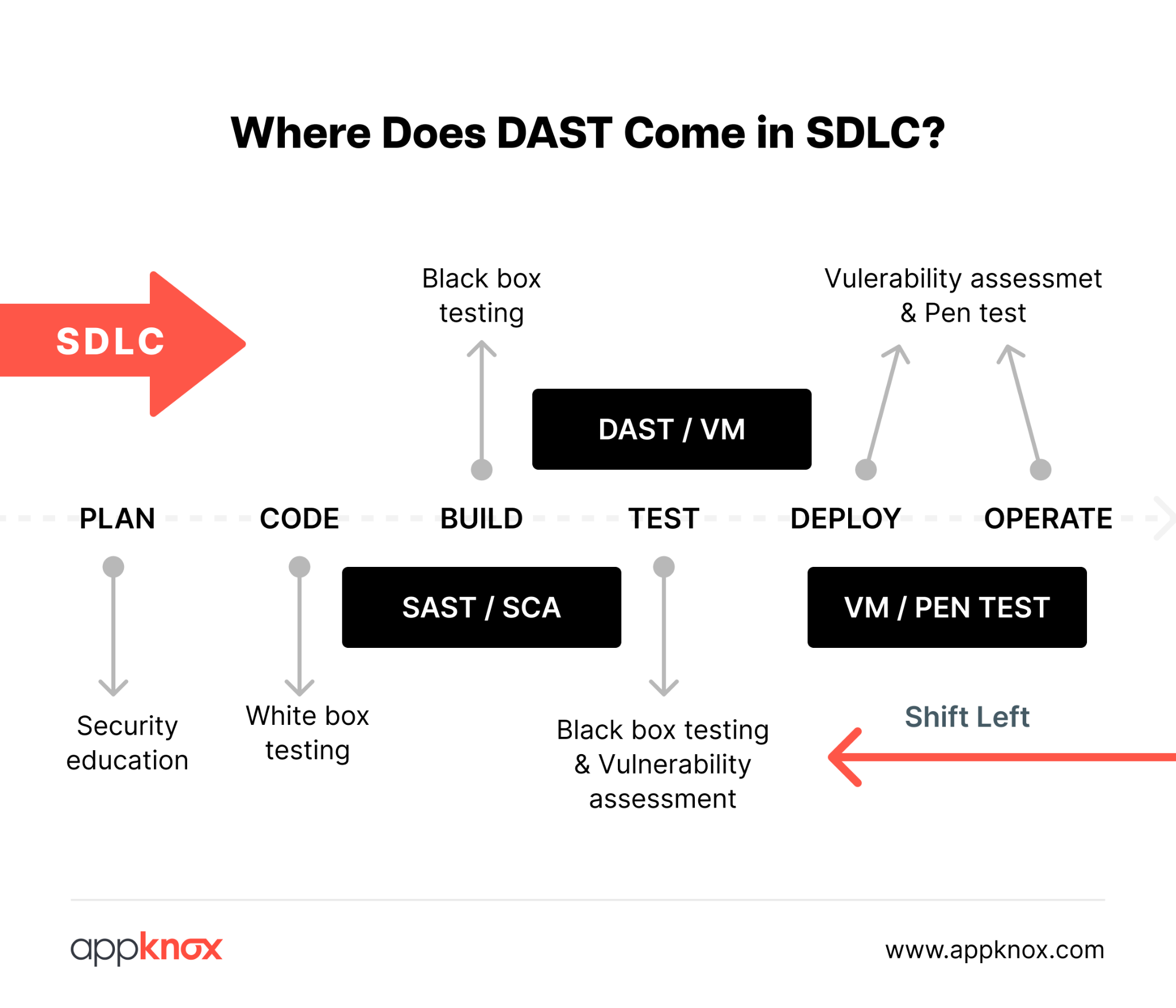
BLOG

BLOG
Dynamic Application Security Testing (DAST) is an advanced scanning method that tests the production environment and analyzes application security at runtime. This type of black box testing identifies real-world vulnerabilities externally without much need for insights into the product's provenance of any single component.
This approach is essential for organizations to strengthen their application security, ensure compliance, and protect against evolving cyber threats.
By simulating real-world attacks in your system, DAST identifies critical security gaps that other vulnerability assessments and static methods might miss. This miss is the difference between a secure application and a leaky bucket, which can result in:
You can only understand its partial security posture without testing your application at run time. This will blind you to specific vulnerabilities that are apparent only during interactions between various system components in the live environment, leading to a false sense of security.
So, dynamic application security testing is more operational and behavioral. It helps identify problems during use and traces them back to their software design origins.

Furthermore, DAST is technology, language, and platform-agnostic.
By closely monitoring the application’s behavior under attack, DAST helps identify security vulnerabilities that hackers might exploit, such as:
While static application security testing (SAST) examines the source code, DAST simulates real-world attacks to uncover vulnerabilities that malicious actors could exploit.
There are five key advantages to DAST:
To maintain the efficiency of these benefits, DAST demands ongoing monitoring, which can become time-intensive.
Appknox addresses this by offering automated DAST, which simulates real-time user interactions to test applications efficiently.

The tool helps detect and mitigate security vulnerabilities early, making it the most effective automated dynamic application testing tool in the application security domain.
Traditional DAST tools have helped identify applications' vulnerabilities, but have notable limitations.
Since they haven’t incorporated new technologies like AI, machine learning, and automation, they fail to improve DAST tools' accuracy, efficiency, and contextual awareness. This renders the traditional tools ineffective in identifying vulnerabilities in modern, complex applications.
Traditional DAST tools rely on crawling through applications by following links and forms. This means they may miss vulnerabilities in hidden or restricted areas of the application that are not accessible through these navigational paths.
DAST tools can sometimes produce false positives (reporting non-vulnerabilities) or false negatives (missing actual vulnerabilities), which leads to inefficiencies. Security teams must manually verify and filter the results.
Traditional DAST tools may not understand the application's business logic or user roles, resulting in less relevant and actionable findings.
As applications have become more complex and use a broader range of technologies, traditional DAST tools have struggled to keep up with newer vulnerabilities.
The growing need for automation in security testing is particularly relevant for DAST, which can be time-consuming and manual. Automating DAST drastically reduces the time and effort required.
The threat landscape is constantly changing, with new attack vectors and techniques emerging. Traditional DAST needs to adapt and incorporate new capabilities to keep up with these evolving threats.
Traditional DAST tools struggle to effectively test applications that require user authentication and complex session handling. This is a significant limitation, as many modern applications rely on these security mechanisms.
Traditional DAST is where runtime testing can significantly strain the application and its associated resources. DAST tools are also typically unable to analyze the flow of data within the organization, which can lead to security lapses in data silos.
Traditional DAST fails to provide comprehensive security testing for APIs, which are increasingly common in modern applications. DAST is typically conducted in the later stages of the software development lifecycle, so vulnerabilities are identified and fixed less efficiently than if found earlier.

Dynamic Application Security Testing (DAST) analyzes running applications to find security vulnerabilities by simulating real-world attacks. It doesn’t require access to source code but interacts with the application as an external user would.
The process typically involves:
Since DAST operates in a runtime environment, it effectively identifies security flaws that only appear during application execution.
Integrating DAST into your security strategy ensures continuous protection against evolving cyber threats.
When it comes to DAST, we know that a functional and running app is the best place to check its effectiveness because DAST can encounter functional issues while the app is in the testing environment due to constant changes. This makes staging and production environments the perfect running grounds for DAST, and this is where one can reap the maximum benefits out of it.
It is generally recommended that DAST in CD be automated by triggering scans during staging itself. After completing unit tests and SAST, you should trigger your DAST scan automatically.
You can also customize your flow based on your needs. How you proceed with this purely depends on your risk-taking ability, company policies, and the type of your application.
Based on your security requirements, it is recommended that you schedule periodic DAST scans. Since these tests take a while to complete, starting them at night, after a day of work, is recommended.
To run scheduled tests successfully and maintain the health of your pipelines, it is better to create separate pipelines instead of integrating them into the staging pipelines.
The best practices for automated dynamic application security testing (DAST) ensure that the testing process is thorough, efficient, and effective in identifying and mitigating security vulnerabilities.

Developers assess vulnerabilities identified in scans, validate findings to minimize false positives and collaborate with security teams to ensure effective resolution and ongoing security improvements.
Sure, open-source security frameworks can help you get started with the security analysis of your first application, but they lack the following:
Given the time and effort required to test multiple applications, the quality of open-source application security tools still lacks commercial value.
Check out why you should opt for a MobSF alternative for comprehensive security coverage of your portfolio of applications.
DAST runs your application and analyzes it for vulnerabilities, ensuring it is secure even before deployment.

When integrated into DevSecOps, DAST prioritizes security equally, ensuring that applications are functional and safe from potential threats.

The advantage of automated DAST is that your testing team can control the results and ensure a lower false positive rate when testing your applications on real devices in a regulated environment. This will also lead to identifying more application configuration issues than other vulnerability assessment methods.
An automated DAST solution like Appknox simulates real-time user interactions and tests the app to analyze and detect security vulnerabilities early on. It helps fix business issues and protects your application from network and runtime threats, such as man-in-the-middle attacks. Eliminating security threats reduces development-to-release time.
As one of the best dynamic application security tools, Appknox’s automated DAST platform cleared security testing 75% faster than the average release time. It is a comprehensive solution that integrates with developers’ existing tools and processes—enabling security teams to work in parallel with development teams.
The key features of Appknox’s automated dynamic analysis solution are:
To learn more about Appknox’s automated DAST platform, book a demo with our security experts.

